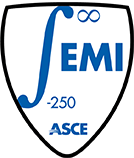MIT Geometric Nonlinearities in Thin Elastic Structures
Massachusetts Institute of Technology
Problems
The paradigm of studying the mechanics of thin structures (rods, plates or shells) is a field with a long history that is being revived and is rapidly burgeoning in new contexts. This effort is bringing together seemingly separate communities ranging from structural mechanics, statistical physics, differential geometry and nanotechnology, which has led to considerable fundamental development in the field. The main source of the complexity in the predictive understanding of thin structures is that, even if the material properties remain linear during the deformation process, non‐negligible geometric nonlinearities can arise that are system independent. These universal modes of deformation underlie the fact that similar phenomena can be observed over a wide range of lengthscales (small and large). This opens the way to approach applications in a unified way, without the need to work at the original scale that motivated the problem.
Approach
We focus on the predictive understanding of the nonlinear deformation of thin elastic objects, where geometry is the primary ingredient. The starting point of our investigations is often through precision desktop‐scaled experiments. We make use of rapid prototyping techniques to have full control on the fabrication of our samples and then employ precision digital measurement and imaging techniques to quantify the deformation processes. We have found this platform to be highly successful in using our model experiments to help us gain the required intuitive knowledge on the system at hand to develop predictive mathematical models and then scale the acquired leanings back to the original length scale of the problem. The prominence of geometry in the mechanics of this class of problems makes this scaled approach particularly relevant.
Findings
A number of recent investigations of our own have proved this approach to be both relevant and successful. For example, understanding why the tearing of macroscopic adhesive films (e.g. scotch tape) leads to triangular tears guided the introduction of a novel technique for fabricating tapered graphene nanoribbons. Also, the macroscopic experiments on the delamination of adhesive films is informing the design and layout of interconnects in novel stretchable electronics devices. More recently, we have found that the self-similar hierarchy of wrinkles observed in hanging window-curtains is identical to the pattern observed in wrinkled ultra-thin films, such as graphene, under boundary confinement. From simple geometry arguments and energy scalings, we have developed a formalism based on wrinklons (the transition zones in the merging of two wrinkles) as building-blocks of the global localization patterns. Even under relatively simple modes of deformation from a solid mechanics perspective (e.g. pure bending of a thin plate), coupling the elasticity of soft mechanical structures with other phenomena such as hydrodynamic forces at a liquid interface, can lead to surprisingly results. In this context, and inspired by floating flowers, we have introduced a novel passive pipetting mechanism for grabbing water with a petal-shaped flexible solid.
Impact
The significance of studying this class of problems is twofold. The first is fundamental as we aim to identify, decipher and classify the universal modes of deformation in thin structures as well as develop a relevant body of predictive mechanical understanding. The second is the high potential impact for applications. Relevant industrial instances of the large deformation of thin structures include, to name just a few, stretchable electronic components, 3‐D printing technologies, wellbore drilling and the laying down of transoceanic cable/pipelines in the ocean bed. More generally, the ultimate goal of our research is to understand and harvest mechanical instabilities towards exploiting novel functionalities in soft mechanical structures, over a wide range of length scales.
Core competencies
- Mechanics of Solid and Structures
- Geometric nonlinearities in thin elastic structures under large deformations
- Fluid‐structure interaction
- Precision model desktop‐scale experiments
Current research team members
- Pedro Reis (PI)
- Arnaud Lazarus (Post-doc)
- Denis Terwagne (Post-doc)
- James Miller (Graduate Student)
- Alice Nasto (Graduate Student)
Current research collaborations
- Katia Bertoldi (Harvard University): Buckling-induced encapsulation with structured elastic shells under pressure;
- Eitan Grinspun (Columbia University) and Basile Audoly (CNRS and Institue d'Alembert, UPMC, Paris): Nonlinear Pattern Formation in the Deposition of Elastic Rods
Industrial partners
- Schlumberger Doll Research


